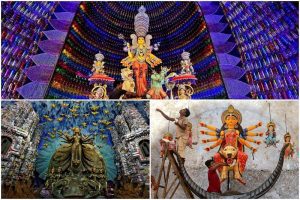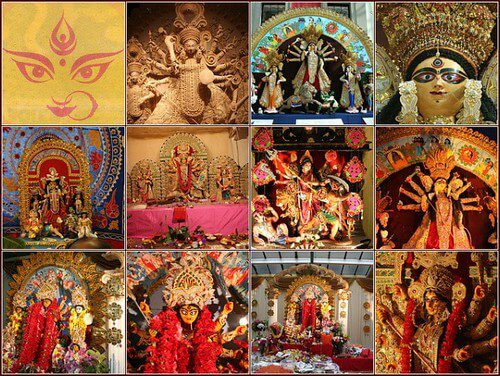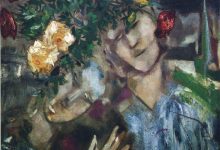It was amazing to see how the festive diaspora opened a wider canvas of different arts, colours and art movements in Kolkata, says Tapati, recollecting the Durga Puja celebrations, in two parts, earlier this month. An exclusive for Different Truths.
In the pleasant onset of autumn when flaky flowering Kashphool give the riverbanks of Bengal almost an artistic makeover by the brush of Nature, the breeze wafts the distant sound of Dhak (war drums) indicating the visit of Durga. In early October, we celebrated the biggest festival of Kolkata, while Navaratri is celebrated in other parts of the country. This year was a coming back home after almost fifty years into the land I was grown up; also, a time to witness that much was happening that escaped attention from distant lands. If my memory, Kolkata was one of endless chaos, narrow and potholed roads with unpleasant sweating and heaped garbage strewn around; now it is changed. It was amazing to see how the festive diaspora opened a wider canvas of different arts, colours and art movements in Kolkata, the new faces of Kolkata I admired and loved to the core.
The myriad of themes reflected in the Durga Puja festival left me awe-struck.
Bengalis are known for their artistic percipience and intelligentsia but the general mass discussing and analysing the concepts, while moving in an ocean of onlookers was a scene worth great applause. The myriad of themes reflected in the Durga Puja festival left me awe-struck.
Durga known to vanquish evil was invoked to combat climate change and global warming. Several organisers had woven the themes of their Puja decorations around environmental concerns; the concept combined festive mood with social responsibility. They created an instant connect and spread messages. I was awed to see how people from grass-root level were being concerned about environmental issues and relating to the themes, engaging themselves in critical viewing.
At one place the model of a city was created where all the water has dried up. This reminds of a similar situation in Chennai in last summer where drinking water became so scarce that water rationing was introduced.
At one place the model of a city was created where all the water has dried up. This reminds of a similar situation in Chennai in last summer where drinking water became so scarce that water rationing was introduced. “We hear about climate change, but do we actually know where it can lead to?, the crowd whispered.
Another pandal resembled a tram car and the deity was placed in the artificial tram terminus. The artwork inside depicted how trams evolved and the role they played in modern scenario of polluted roads. There was instant comment from the crowd, “It was not only a part of Kolkata’s heritage but also an ecofriendly mode of transport, a solution to rising pollution.”

The theme of one Pandal was Parnachaya, aiming to remind the beauty and bounties of Nature and the importance of conservation, while in another place the decoration was like a nursery of plants.
The theme of one Pandal was Parnachaya, aiming to remind the beauty and bounties of Nature and the importance of conservation, while in another place the decoration was like a nursery of plants. They wanted to make people aware on the need to protect vegetation. Comments were loud, “We need more trees if we want the earth to survive.”
One place depicted the Nava Patrika or the nine plants the Devi stands for. It directed people to walk in under an arch of branches of a chopped tree from which twigs were sprouting, in the tree’s desperate bid to live. In the outer section eight forms of the Patrika or plants were created on relief on walls of both sides. At the centre, there was an installation of a tree in which a tree-shaped man and woman were locked in embrace with a child on one side. The goddess was imagined as turmeric, the ninth plant.
Another organisation recreated a Darjeeling tea garden. There was also a Buddhist monastery along with the tea garden in Chamong.
A picture of tribal life was beautifully created at one place. The inner walls coated in clay had waves in relief over which slam boars of palm tree trunk would sail. To the right, a tribal goddess was seated against a background of earthen tiles.
A picture of tribal life was beautifully created at one place. The inner walls coated in clay had waves in relief over which slam boars of palm tree trunk would sail. To the right, a tribal goddess was seated against a background of earthen tiles. Elsewhere the pandal was a huge hut decorated with accessories used in tribal life like coconut leaf broom, coconut bark, date palm leaf, jute sticks, clay handis and earthen tiles. The goddess stood on a buffalo on whose horn stood the divine children.
Women artists from Hazaribag in Jharkhand were specially invited in a place called Haridevpur to decorate their pandal with Sohrai and Khovar painting. The special story about the women artisans is that only married women can do the painting, the art is being passed on generation by generation. This Sohrai and Khovar are one of the oldest forms of wall-painting which started in the form of cave-painting since pre-historic times and continued as painting on mud-walls. Materials used are different kinds of mud. They use comb to make a special type of artistry in marriage ceremony to symbolize a new beginning.
In Jodhpur Park, the theme revolved around the idea of creation with the Mandap as a shrine of Shiva, the creator.
In Jodhpur Park, the theme revolved around the idea of creation with the Mandap as a shrine of Shiva, the creator. They created earthen installations and used soil and ash to decorate the pandal.
Students of one Government College of Arts and Crafts attempted to depict separate facets of Durga, an ordinary home-maker to a vanquisher of evil. The Devi was portrayed with visual cohesion of various cosmic life forms. Another all-women team tried to project peace and prosperity through lotus flower; lotus is offered to the goddess on Durga Puja; it is considered to be auspicious and sacred because though it flourishes in muddy water, it retains its purity.
So many creative minds went through hours of hard work with immense patience over months to create these beautiful pieces of art on such a large scale was unbelievable. The city was dazzling throughout the nights, people walking and enjoying the decorations.
Photos from the Internet






 By
By
 By
By
 By
By